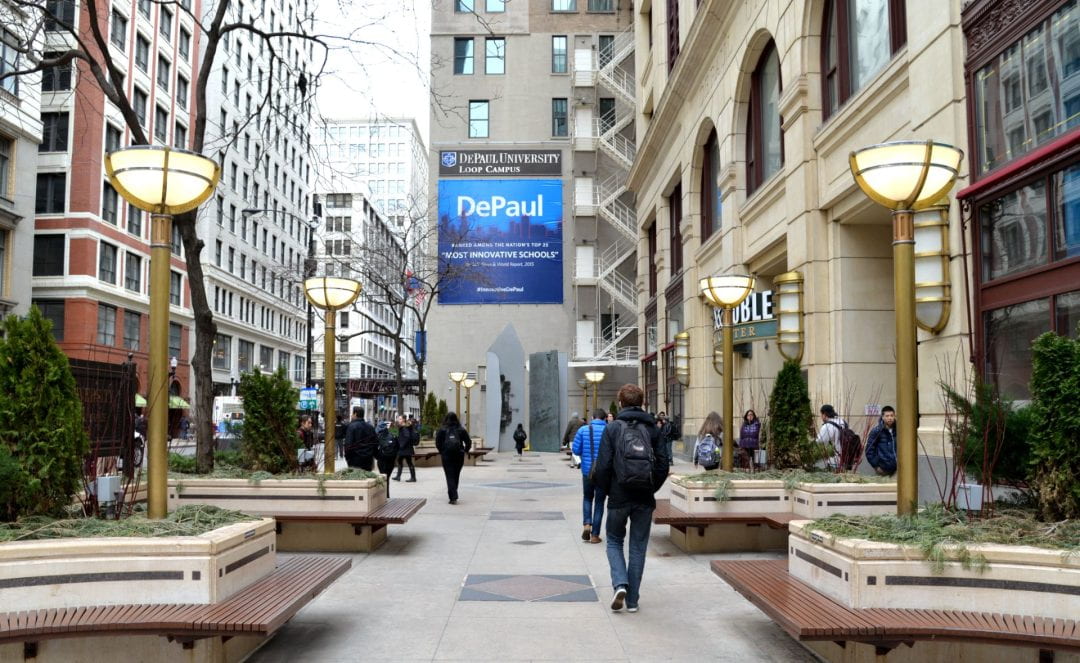
Nick DiMaggio (MBA ’21) is now a consultant at Gallup
Today, Nick DiMaggio (MBA ’21) is a business strategy consultant at Gallup.
Just a few years ago, DiMaggio was enrolled in the full-time MBA program at Kellstadt.
It was the height of the COVID-19 pandemic. Business was changing, and fast.
DiMaggio was at a turning point of his own. He had grown up in a family of business owners; conversations about “people, process, and products” were standard dinner-table fare. He had garnered extensive experience in sales across multiple industries. He aspired to one day lead a Fortune 500 company.
To get there, he’d realized, the best next step was to become an enterprise strategy consultant.
“I was looking around for programs that could help me do that effectively,” DiMaggio says. Two things stood out about Kellstadt. First, its business strategy concentration. And second, the ability to create a custom MBA concentration.
“This gave me flexibility,” DiMaggio says. “And it gave me the opportunity to stretch my business strategy skills.”
Read on for DiMaggio’s reflections on how Kellstadt equipped him to make an impact – and for how you can make the most out of your time in Kellstadt’s MBA program.
Find someone whose vision aligns with yours
“It’s important to find those professors who see the light,” DiMaggio says, “but can also challenge you.”
For DiMaggio, that person was Rafael Tenorio. A professor of economics, Tenorio approaches business strategy and decision-making by deploying tools from behavioral finance and game theory.
“Humans often act illogically,” DiMaggio says, describing one of the core tenets of behavioral economics. “We as humans understand that every day. Take going to the grocery store. We don’t need the Kit Kat bar. We know that. But every time, you find yourself buying it.”
Historically, researchers excluded irrationality from their models of the economy. A key insight of behavioral economics is that these models work better when researchers find ways to add irrationality – human behavior as it actually functions – back in.
“These undertows flow through our daily world,” says DiMaggio. He recognized them from his experience in sales. But have a “framework,” he says, made all the difference in his ability to harness insights from behavioral economics in his career.
Get the reps in
Another thing DiMaggio says was key to launching his career change? Putting theory into practice – and doing so over and over again.
He likens the hands-on learning he experienced at Kellstadt to a workout.
Learning new tactics, he says, is all about “getting the reps in.”
He cites a business strategy class as one example. He and the rest of his full-time MBA cohort got the chance to run a simulated market. This meant that students weren’t just practicing the strategies they studied. They were seeing how their actions impacted the market as a whole.
“How does the market move?” recalls DiMaggio. “How do the decisions we make help our company move forward?”
The exercise was meaningful precisely because students could see the results of their choices. In this regard, it was far from alone.
Work with real businesses on real challenges
A consulting class, DiMaggio says, took putting theory into practice to the next level.
Student groups partnered with firms to address urgent challenges. Many of these firms, DiMaggio says, were connected to the class via DePaul alumni.
DiMaggio’s group partnered with a third-party logistics company. The company’s charge for the MBA students: At a time when logistics are more essential – and complicated – than ever, how do you increase the retention of truck drivers?
In tackling this challenge, DiMaggio received guidance informed by on-the ground experience.
“Our professor was doing consulting himself,” DiMaggio says. This allowed him to teach models in a way that made their practical applications clear.
At the end of the quarter, the group presented their research to leaders at the firm. The group didn’t get to see the end results of their work. Instead, it functioned as a starting point. Equipped with the team’s thorough research, leaders would be able to conduct further analysis of their own.
Getting to work directly with key decision-makers, DiMaggio says, was an invaluable opportunity.
“These were real-world problems that we got to work on,” he says. “These businesses needed our perspective to move the needle.”
Be an entrepreneur in your own education
Looking back, DiMaggio sees his Kellstadt experience as lying the perfect intersection of three fields: business strategy, behavioral economics and game theory. DiMaggio’s passion and skillset led him to that intersection. At Kellstadt, he found the expertise and hands-on learning to combine the three areas.
Now, that intersection has become the launch point for the next phase of DiMaggio’s career.
“At Gallup, I found the intersection that I want to base my career on,” he says. In his consulting work today, he is able to combine all three areas of expertise. This has been especially impactful, he says, when he is able to help businesses keep employees engaged.
“Engagement can be linked directly to business outcomes,” says DiMaggio. “Think about productivity, or turnover, or sales — the list goes on and on.”
DiMaggio is able to trace that impact directly back to his approach to Kellstadt.
“It is your job, no matter where you go, to have an entrepreneurial spirit,” he reflects. “By having a custom MBA, Kellstadt gives you the ability to be that entrepreneur in your own education. To find your interests – and then double down on them. To build the network around you that will allow you to make that career change – and successfully launch it.”



Recent Comments